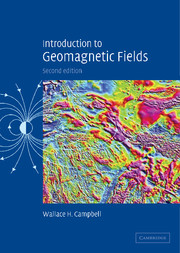Book contents
- Frontmatter
- Contents
- Preface
- Acknowledgements
- 1 The Earth's main field
- 2 Quiet-time field variations and dynamo currents
- 3 Solar–terrestrial activity
- 4 Measurement methods
- 5 Applications
- Appendix A Mathematical topics
- Appendix B Geomagnetic organizations, services, and bibliography
- Appendix C Utility programs for geomagnetic fields
- References
- Index
4 - Measurement methods
Published online by Cambridge University Press: 05 June 2012
- Frontmatter
- Contents
- Preface
- Acknowledgements
- 1 The Earth's main field
- 2 Quiet-time field variations and dynamo currents
- 3 Solar–terrestrial activity
- 4 Measurement methods
- 5 Applications
- Appendix A Mathematical topics
- Appendix B Geomagnetic organizations, services, and bibliography
- Appendix C Utility programs for geomagnetic fields
- References
- Index
Summary
Introduction
Man has no obvious sensation of the presence or change of the Earth's magnetic field such as he does for the sensation of rain, wind, or earthquakes. He must rely upon the field's interaction in other physical processes to produce measurable effects. In this chapter we will look at some methods of providing such geomagnetic information.
From a physicist's viewpoint the geomagnetic field we wish to measure has some interesting singular characteristics. It is ever-present; we must take deliberate action to create any required field-free environments. Because of the great spatial extent of the field with respect to available sensor dimensions, only single-point measurements are typically obtained. The natural field is constantly changing and cannot be stopped at will by the experimenter. A conglomeration of Earth-core, magnetospheric, ionospheric, and induced currents all contribute to the simple measurement of a geomagnetic field magnitude and direction at each instant of time; occasionally, special frequency-analysis techniques allow us to identify some of these contributing sources.
The Earth's field changes are not easily stoppered in a bottle and brought to the laboratory for testing like a paleomagnetic rock sample. Those who want the measurement usually must move to a sampling spot that they have selected with care in order to minimize unwanted “noise” and to indicate special upper-atmosphere or deep-Earth characteristics. Everywhere at the Earth's surface, the “steady” field (i.e., slowly varying with respect to the spectral components at active times) is quite strong compared to the relatively infinitesimal fields of rapid (micro) pulsations.
- Type
- Chapter
- Information
- Introduction to Geomagnetic Fields , pp. 189 - 227Publisher: Cambridge University PressPrint publication year: 2003



